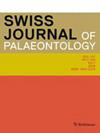Monte San Giorgio 的中三叠世古生物群以及对 Merithone laetitiae (†Permithonidae) gen.
IF 3
2区 地球科学
Q1 PALEONTOLOGY
引用次数: 0
摘要
三叠纪被认为是建立现代昆虫动物群的关键时期,这一时期的化石记录对于了解二叠纪末大灭绝事件对这些动物的真正影响至关重要。在这里,我们回顾了这一时期世界主要矿床之一--圣乔治山(Monte San Giorgio)--的昆虫化石,该矿床被认为是世界九大昆虫化石矿床之一。在这个位于瑞士和意大利交界处的昆虫化石采集站,共在五个地方采集到 273 块昆虫化石。瓦尔马拉遗址 D 是圣乔治山昆虫化石最丰富的两个遗址之一,在这里发现的化石具有一些特殊的特征,如体积特别大,内部组织磷化,显示出内部的精细细节。相比之下,瓦尔马拉遗址 VM 12 的化石记录(248 个标本)以中小型昆虫为主,通常几乎完好无损,保留了翅膀上的刚毛和复眼等细节。除了这些特殊的特征外,这些昆虫化石在进化过程中也具有极其重要的意义,因为它们代表了其家族的首次或最后一次出现。在这方面,利用它们来校准系统发生学年代分析中的节点,可以追溯包括双翅目和杂翅目在内的许多昆虫谱系的起源。迄今为止,圣乔治山共有五个物种被正式描述,分别属于古生代目(†Monura 和 Machilidae)、蜉蝣目、半翅目(Tingidae)和鞘翅目(Adephaga)。本研究还描述了另一个物种 Merithone laetitiae (†Permithonidae) gen.本文章由计算机程序翻译,如有差异,请以英文原文为准。
The Middle Triassic palaeontomofauna of Monte San Giorgio with the description of Merithone laetitiae (†Permithonidae) gen. et sp. nov.
The Triassic is considered a crucial period for the establishment of the modern insect fauna and fossil records from this period are fundamental for understanding the real impact that the end Permian Mass Extinction events had on these animals. Here, we review the insect fossils from one of the main deposits of this period in the world, Monte San Giorgio, which is considered one of the nine main insect Fossillagerstätten. In this Lagerstätte, located on the border between Switzerland and Italy, a total of 273 fossil insects have been collected in five localities. The fossils found in Val Mara site D, one of the two richest insect fossils sites of Monte San Giorgio, present peculiar features, such as extraordinary sizes and phosphatisation of internal tissues revealing fine internal details. In contrast, the Val Mara site VM 12 fossil record (248 specimens) is dominated by small to medium size insects, usually almost intact, preserving details such as setae on wings and compound eyes. Besides these exceptional features, these fossil insects are of extreme evolutionary importance, since they represent the first or the last occurrence for their lineage. In this regard, their use to calibrate nodes in a phylogenomic dating analysis led to backdating the origin of many insect lineages, including Diptera and Heteroptera. Up to now, a total of five species from Monte San Giorgio have been formally described, belonging to the orders Archaeognatha (†Monura and Machilidae), Ephemeroptera, Hemiptera (Tingidae) and Coleoptera (Adephaga). A further species, Merithone laetitiae (†Permithonidae) gen. et sp. nov., whose fossil is included among the recent findings in Val Mara site VM 12, is described in the present work.
求助全文
通过发布文献求助,成功后即可免费获取论文全文。
去求助
来源期刊

Swiss Journal of Palaeontology
Earth and Planetary Sciences-Paleontology
CiteScore
4.30
自引率
16.70%
发文量
17
审稿时长
4 weeks
期刊介绍:
The Swiss Journal of Palaeontology publishes original research and review articles of interest to the international community in the fields of palaeontology, taxonomy and systematics, while recognising at the same time the importance of documenting high-quality palaeontological data in a regional context. Palaeobiology in combination with alpha taxonomy is a core topic of the journal.
Submitted papers should have an appeal as wide as possible, directed towards an international readership. Contributions should not have been simultaneously submitted elsewhere, and the overlap of content between related articles should be minimal. Duplications of text and the use of previously published illustrations without adequate citation are unacceptable. If a manuscript has two or more authors, both or all have to sign to confirm they all were involved in the work and have agreed to its submission. The preferred manuscript language is UK English, but consistently used US English is also acceptable. We encourage the publication of proceedings of international meetings as well as special thematic issues. Short contributions and book reviews are also accepted.
An international editorial team as well as guest editors guarantee that the thematic issues as well as all articles in regular issues are peer-reviewed and meet the highest standards.
 求助内容:
求助内容: 应助结果提醒方式:
应助结果提醒方式:


